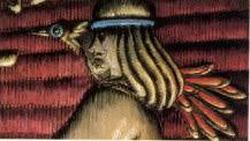Miyazaki Madness (Nausicaa of the Valley of the Wind)
Visited the Land of Watching Miyazaki While Nibbling Pocky Sticks and Drinking Genmaicha. Hayao Miyazaki was named one of the 100 most influential people in the world by TIME rag.
Nausicaä of the Valley of the Wind
Nausicaä of the Valley of the Wind was Hayao Miyazaki's first work. The main character sprang fully grown from the mind of Miyazaki, an amalgamation of the princess who rescued Odysseus in Homer's "The Odyssey" and the eccentric princess from the Japanese book of fairy tales "Tsutsumi Chunagon Monogatari", written at the end of the 12th century, who loved insects and worms while other princesses loved butterflies.

Miyazaki's story is set in a post-apocalyptic world beset by pollution and poison. The remaining small pockets of humans scratch out a fearful existence as they can, ever vigilant against the spreading ecological disaster. The Valley of the Wind is a human colony more protected than others, with lush green fields, bubbling streams, windmills, and a happy community who love and submit to the royal family. But even in the Valley of the Wind, the plants, air and water are polluted. The king cannot help his little kingdom; he himself is dying from the pollution.
There is legend that only the old (read: wise, not senile) believe: that there will come a hero, a person clad in blue, standing in a golden field who will find the bond between humanity and the earth, and lead the people to a pure land. The wisest, most respected and well-loved teacher of the Valley of the Wind travels untiringly through the world in search of this person.

Like all good tales, the hero, of course, is real and much closer than even the wisest teacher could have guessed; the hero, or rather the heroine, is Nausicaä herself. Her compassion for the hostile insects, wisdom in dealing with them, courage and love for her people cause her to sacrifice her life to save them. There is a resurrection scene where she is brought to life again (wearing the requisite blue, standing on a field of golden feelers) and the Valley is restored to its lush state and better. For a more detailed synopsis, see here.

A Christian allegory? Hardly! In fact, Miyazaki is known to be anti-Organised Religion and gave himself a hard time for inadvertently writing something with so much religious overtone. It's quite amazing that someone so adverse to any sort of religious leanings should, in his happiest fantasy, dream up something that so approximates reality as God tells it.
In God's reality, there was foretold for thousands of years a hero, a messiah, who would save the world from the pollution of sin and the terror of judgement. When this promised saviour finally came, he seemed to be an ordinary man like any other. But he was actually the Son of God and was sinless. By sacrificing his innocent life, he restored the relationship of all humanity with God and the relationship of humanity with the earth. And now, those who trust in him can partake of this marvellous restoration and look forward to the day when there will be a new heaven and a new earth, when not only with harmony between God and us and the rest of creation be restored, but it will be even better than before.
Miyazaki's fantasy is good. That something better than Miyazaki could have ever imagined is already set in motion in reality is far far better.
All images from Studio Ghibli.
Shadow would like to acquire a diaeresis so Shädow can be cool like Nausicaä (without attendant butt-baring on mehves).
Nausicaä of the Valley of the Wind
Nausicaä of the Valley of the Wind was Hayao Miyazaki's first work. The main character sprang fully grown from the mind of Miyazaki, an amalgamation of the princess who rescued Odysseus in Homer's "The Odyssey" and the eccentric princess from the Japanese book of fairy tales "Tsutsumi Chunagon Monogatari", written at the end of the 12th century, who loved insects and worms while other princesses loved butterflies.

There is legend that only the old (read: wise, not senile) believe: that there will come a hero, a person clad in blue, standing in a golden field who will find the bond between humanity and the earth, and lead the people to a pure land. The wisest, most respected and well-loved teacher of the Valley of the Wind travels untiringly through the world in search of this person.


In God's reality, there was foretold for thousands of years a hero, a messiah, who would save the world from the pollution of sin and the terror of judgement. When this promised saviour finally came, he seemed to be an ordinary man like any other. But he was actually the Son of God and was sinless. By sacrificing his innocent life, he restored the relationship of all humanity with God and the relationship of humanity with the earth. And now, those who trust in him can partake of this marvellous restoration and look forward to the day when there will be a new heaven and a new earth, when not only with harmony between God and us and the rest of creation be restored, but it will be even better than before.
Miyazaki's fantasy is good. That something better than Miyazaki could have ever imagined is already set in motion in reality is far far better.
*******
Miyazaki Madness, Ecology & God's Environmental Rescue PlanAll images from Studio Ghibli.
Shadow would like to acquire a diaeresis so Shädow can be cool like Nausicaä (without attendant butt-baring on mehves).
Labels: Films, Hayao Miyazaki







<< Home